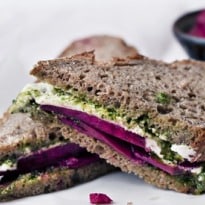As a child of the 60s and, by nine, making my own sandwiches for school, the idea of something delicious tucked between two slices of bread has always appealed. For me, sandwich perfection is just as much about texture as it is about flavour, and none better than when something soft and creamy teams up with something sharp and crisp. I may have moved on a bit since the days of my carefully crafted Primula cheese spread and cucumber on white sliced Wonderloaf, but the principle is much the same. You take bread - something soft, spreadable and slightly salty - and marry it to something thin, fresh and crisp.
Today that might mean dark rye bread with creamed, seasoned goat's curd and paper-thin beetroot, briefly pickled so it is still crisp. The basic story is the same, it's just that the characters have grown up a bit.
Making a sandwich is something to which I like to give a great deal of thought, unless it's late and I've come home a bit drunk, in which case pretty much anything I can find in the fridge held prisoner between two slices of bread would probably be good as long as it has enough mayo on it.
I have never understood why a sandwich can't be a thing of beauty if we want it to be: the right bread for the filling; the introduction of imagination or whim; the decision to toast or not. This week I really went to town with a fish sandwich for lunch. Rather than butter, I made a spread like an adult-rated potted fish paste. (Hot smoked salmon and crème fraîche replacing the Shippams of my childhood.) The essential crunch came from curls of carrot which I crisped up in a bowl of iced water, though it could just have easily been radishes. Filled with fried fish (I used pollock), this was always meant to be a light lunch rather than a snack. Gloriously messy to eat and a mixture of hot, crisp, soft and refreshing, it hit every spot you could wish for.
The addition of a crunchy element can come in many forms, but proves a particularly winning element for me when it also happens to be piquant. An instant answer would be slices of gherkin or halved tiny cornichons fished from a jar or perhaps shreds of pickled sushi ginger. For a more planned version, I made a quick pickle with beetroot, vinegar and spices, but it could just as easily have been cucumber or pieces of carrot marinated for an hour or two in a pickling liquor. Something crisp and sharp for my perfect summer sandwich.
Goat's curd with crisp pickled beetroot
You will have more pickled beetroot than you need. It will keep for a few day in the fridge. Bear in mind that it is not a traditional hot pickle, so won't keep for more than a week.
Makes 4 sandwiches, enough for 2
horseradish 30g, fresh root
beetroot 350g, small and raw
black peppercorns 15
red-wine vinegar 200ml
malt vinegar 150ml
walnut 65g, halves
rocket leaves 75g
olive oil 8 tbsp
goat's curd or cream cheese 200g
dark rye bread 8 thin slices
Peel the beetroot and cut into paper-thin discs. Finely grate the fresh horseradish root. Layer the slices of beetroot in a jar, scattering the layers with a little of the grated horseradish and a few peppercorns as you go.
Pour the red-wine and malt vinegars into the jar (there is no need to heat the mixture - this is not a preserve) then seal and set aside for at least 4 hours.
In a shallow pan, toast the walnut halves until deep brown. Keep an eye on them. They burn the moment your back is turned. Put the walnuts into the bowl of a food processor and add the rocket leaves. Pour in the olive oil and process to a coarse paste.
Season the goat's curd with a little black pepper. Spread the rye bread with a generous layer of the rocket and walnut paste, then a layer of goat's curd and some of the beetroot slices. Place a second slice of rye bread on top and gently press down. Slice and eat.
Pollock and salmon baguette
Makes 3 large sandwiches
hot-smoked salmon 350g
crème fraîche 100g
Dijon mustard 1-2 tbsp
spring carrots 2, small
olive oil a little
pollock or other white fish 400g
baguette 1, short and thin
spring onions 2
dill a few sprigs
Peel the salmon from its skin, then put the flesh into the bowl of a food processor with the crème fraîche, mustard and a little salt and pepper. The amount of mustard is up to you. Process briefly to a coarse paste (just a second or two). Set aside.
Using a vegetable peeler, cut the carrot into thin shavings. (If you can be bothered, drop them into a bowl of iced water to crisp and curl.) Finely shred the spring onions.
Warm a little oil in a nonstick pan. Season the pollock with salt and pepper, then lay the fillets gently into the hot oil, skin-side down, and leave to cook for 3 or 4 minutes until the skin is crisp, then turn and continue cooking until the other side is golden. Remove the fish from the pan and leave to drain on kitchen paper.
Slice the baguette into three, then open, spread generously on both cut sides with salmon paste (you will have some left over) then stuff in the carrot shavings, the shredded spring onion and a few sprigs of dill. Tuck pieces of the warm pollock inside and eat immediately.
Email Nigel at nigel.slater@observer.co.uk. Follow Nigel on Twitter @NigelSlater
Slice of life: Nigel Slater's goat's curd with crisp pickled beetroot sandwich. Photograph: Jonathan Lovekin for the Observer









